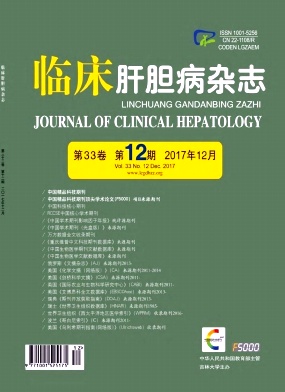|
[1]HONG SN, LEE SY, CHOI MS, et al.Comparing the outcomes of radiofrequency ablation and surgery in patients with a single small hepatocellular carcinoma and well-preserved hepatic function[J].J Clin Gastroenterol, 2005, 39 (3) :247-252.
|
|
[2]FAN J, ZHOU J, YANG XR.Surgical treatment of hepatocellular carcinoma in the precision medicine era[J].Chin J Dig Surg, 2017, 16 (1) :22-27. (in Chinese) 樊嘉, 周俭, 杨欣荣.精准医学时代的肝癌外科治疗[J].中华消化外科杂志, 2017, 16 (1) :22-27.
|
|
[3]ZHANG CS, ZHANG JL, LI XH, et al.Is radiofrequency ablation equal to surgical re-resection for recurrent hepatocellular carcinoma meeting the Milan criteria a meta-analysis[J].J Buon, 2015, 20 (1) :223-230.
|
|
[4]BENEDICT SH, YENICE KM, FOLLOWILL D, et al.Stereotactic body radiation therapy:the report of AAPM Task Group 101[J].Med Phys, 2010, 37 (8) :4078-4101.
|
|
[5]CHEN AP, SETSER A, ANADKAT MJ, et al.Grading dermatologic adverse events of cancer treatments:the common terminology criteria for adverse events version 4.0[J].J Am Acad Dermatol, 2012, 67 (5) :1025-1039.
|
|
[6]XU XJ, ZHANG Q, PAN JS, et al.Clinical efficacy and adverse reactions of body gamma knife in treatment of primary liver cancer[J].J Jilin Univ:Med Edit, 2017, 43 (2) :402-407. (in Chinese) 徐雪晶, 张倩, 潘绵顺, 等.体部伽玛刀治疗原发性肝癌的临床疗效和不良反应[J].吉林大学学报:医学版, 2017, 43 (2) :402-407.
|
|
[7]CHOI D, LIM HK, RHIM H, et al.Percutaneous radiofrequency ablation for recurrent hepatocellular carcinoma after hepatectomy:longterm results and prognostic factors[J].Ann Surg Oncol, 2007, 14 (8) :2319-2329.
|
|
[8]MA MING, NIU TT, SHAO L, et al.Hepatic transcatheter arterial chemoembolization combined with stereotactic radia tion therapy of primary liver cancer[J].Trauma Crit Med, 2017, 5 (1) :32-35. (in Chinese) 马明, 牛婷婷, 邵亮, 等.肝动脉化疗栓塞术联合立体定向放疗治疗较大原发性肝癌临床研究[J].创伤与急危重病医学, 2017, 5 (1) :32-35.
|
|
[9]LLOVET JM, BRUIX J.Systematic review of randomized trials for unresectable hepatocellular carcinoma:chemoembolization improves survival[J].Hepatology, 2003, 37 (2) :429-442.
|
|
[10]REAL MI, LLOVET JM, MONTANA X, et al.Arterial embolisation or chemoembolisation versus symptomatic treatment in patients with unresectable hepatocellular carcinoma[J].Lancet, 2002, 359 (9319) :1734-1739.
|
|
[11]SHAO L, SHI YX, ZHU HX, et al.Clinical observation of therapeutic effect of primary liver cancer treated by stereotactic radiotherapy combined with kanglaite injection[J].Clin J Med Offic, 2017, 45 (3) :313-315. (in Chinese) 邵亮, 施艳新, 朱慧心, 等.立体定向放射治疗联合康莱特注射液治疗原发性肝癌临床研究[J].临床军医杂志, 2017, 45 (3) :313-315.
|
|
[12]BENSON AB, D'ANGELICA MI, ABRAMS TA, et al.Hepatobiliary cancers, version 2.2014[J].J Natl Compr Canc Netw, 2014, 12 (8) :1152-1182.
|
|
[13]HUANG WY, JEN YM, LEE MS, et al.Stereotactic body radiation therapy in recurrent hepatocellular carcinoma[J].Int J Radiat Oncol Biol Phys, 2012, 84 (2) :355-361.
|
|
[14]LU MD, YIN XY, XIE XY, et al.Percutaneous thermal ablation for recurrent hepatocellular carcinoma after hepatectomy[J].Br JSurg, 2005, 92 (11) :1393-1398.
|
|
[15]YANG W, CHEN MH, YIN SS, et al.Radiofrequency ablation of recurrent hepatocellular carcinoma after hepatectomy:therapeutic efficacy on early and late-phase recurrence[J].AJR Am J Roentgenol, 2006, 186 (5 Suppl) :s275-s283.
|
|
[16]ZHOU Y, SUI C, LI B, et al.Repeat hepatetomy for recurrent hepatocelluar carcinoma after hepatectomy:a local experience and a systematic review[J].Word J Surg Oncol, 2010, 8 (1) :55.
|
|
[17]MARELLI L, STIGLIANO R, TRIANTOS C, et al.Transarterial therapy for hepatocellular carcinoma:Which technique is more effective?A systematic review of cohort and randomized studies[J].Cardiovasc Intervent Radiol, 2007, 30 (1) :6-25.
|
|
[18]BOUZA C, LOPEZ-CUADRADO T, ALCAZAR R, et al.Metaanalysis of percutaneous radiofrequency ablation versus ethanol injection in hepatocellular carcinoma[J].BMC Gastroenterol, 2009, 9 (1) :31.
|
|
[19]Ministry of Health of the People's Republic of China.Diagnosis, management, and treatment of hepatocellular carcinoma (V2011) [J].J Clin Hepatol, 2011, 27 (11) :1141-1159. (in Chinese) 中华人民共和国卫生部.原发性肝癌诊疗规范 (2011年版) [J].临床肝胆病杂志, 2011, 27 (11) :1141-1159.
|
|
[20]LIANG BY.Surgical treatment strategy for hepatocellular carcinoma and prevention and treatment for postoperative tumor recurrence[D].Wuhan:Huazhong Univ Sci Tech, 2012. (in Chinese) 梁宾勇.原发性肝癌外科治疗方法选择及术后肿瘤复发防治的临床和实验研究[D].武汉:华中科技大学, 2012.
|
|
[21]ZHOU L, RUI JA, WANG SB, et al.Early recurrence in large hepatocellular carcinoma after curative hepatic resection:prognostic significance and risk factors[J].Hepatogastroenterology, 2014, 61 (135) :2035-2041.
|
|
[22]FENG AJ, LIU YQ.Effects of laparoscopic hepatectomy and open hepatectomy on C-reactive protein and blood coagulation function in patients with primary liver cancer[J/CD].Chin J Liver Dis:E-lectronic Edition, 2017, 9 (1) :75-78. (in Chinese) 冯爱军, 刘艳芹.腹腔镜规则肝叶切除和开腹对原发性肝癌患者C-反应蛋白和凝血功能的影响[J/CD].中国肝脏病杂志:电子版, 2017, 9 (1) :75-78.
|
|
[23]LIANG HH, XUE P, CHEN MS, et al.Risk factors of survival for recurrent hepatocellular carcinoma treated by percutaneous radiofrequency ablation[J].Chin J Surg, 2010, 48 (10) :738-742. (in Chinese) 梁惠宏, 薛平, 陈敏山, 等.经皮射频消融治疗复发性肝癌的预后分析[J].中华外科杂志, 2010, 48 (10) :738-742.
|







 DownLoad:
DownLoad: